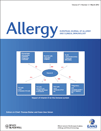Comparative effect of pre-coseasonal and continuous grass sublingual immunotherapy in children
Edited by: Thomas Bieber
Abstract
To cite this article: Stelmach I, Kaluzińska-Parzyszek I, Jerzynska J, Stelmach P, Stelmach W, Majak P. Comparative effect of pre-coseasonal and continuous grass sublingual immunotherapy in children. Allergy 2012; 67: 312–320.
Background: One of the most important aspects of sublingual immunotherapy (SLIT) is the regimen of administration. The aim of the study was to compare the efficacy and the safety of SLIT given pre-coseasonally (starting before the pollen season and continuing until the end of it) and continuously (all year round, independent of the pollen season) in children allergic to grass pollen.
Methods: Sixty children aged 6–18, sensitive only to grass pollen, with rhinitis (20 patients had concomitant asthma) participated in the 2-year prospective, randomized, double-blind, placebo-controlled trial.
Results: Both pre-coseasonal and continuous SLIT were associated with a substantial reduction in the combined symptoms/medication score when compared with placebo; there were no significant differences between the regimens (mean difference: 18.1 ± 12.4, P > 0.05). Similar changes were observed in the total symptoms score. Pre-coseasonal therapy, compared with continuous, was more effective in the reduction of nasal symptoms (mean difference: −18.0 ± 2.5, P = 0.006). We did not observe significant differences in medication, ocular, and asthma scores between the regimens. We did not observe changes in morning PEF, FEV1, and PD20 in any of the three groups nor between the groups throughout the study. We showed a significant decrease in FeNO level comparable in both active groups. There were no differences between groups in the induction of CD4CD25Foxp3-positive cells in peripheral blood during the study.
Conclusion: Both protocols were effective compared with placebo and showed similar decreases for combined symptoms/medication score and all secondary endpoints, with the exception of nasal symptoms that were lower in the pre-coseasonal group.




